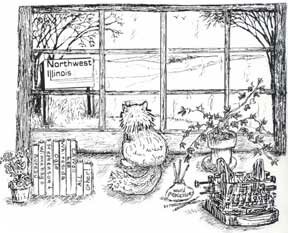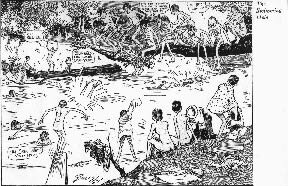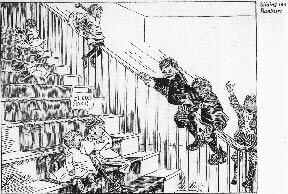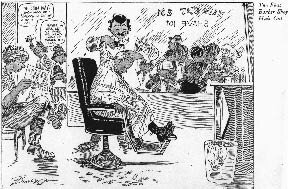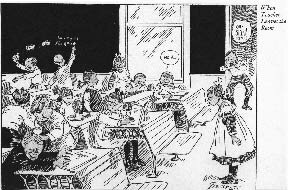
Discover rewarding casino experiences. 
Click on the Flag for More Information |
Those were the words of Clare Briggs whose cartoons had become nationally famous by 1920 when a short article by him appeared in “American” magazine, a popular periodical of that era. He tells in it how his “motto series” had its beginning as the successful way his career took off ... “Hammering home” an idea such as an advertising man would do. By drawing a character a couple times a week in a series, people would recall it. One of the first being “Little Alex” who had the look of Alex Zwilling who played baseball with the White Sox. He was a sweet-faced, innocent looking kid who the artist idealized. Readers began to notice the similarity and then by making “pirates or bandits” of opposing baseball teams, fans began to support the home team. Recent years the Chicago teams had not done well what with sloppy play, illegal activity with no connection to the public. You know the pattern!
Clare Briggs had migrated to Chicago after two lean years in New York where only a few opportunities arose. During that time he’d sent for his dad whose health had failed. Senior Briggs’ had searched for work but was unable to help. Times were thin. Clare had saved a little money and decided to go to Nebraska to marry the patient girl of his dreams, Ruth Owens, of whom he wrote in later years that she was creative and practical and had many fine ideas to further his career. Their love and devotion for the other would be sorely tried in the later years of their union. Although Briggs had sold many sketches, the steady job was out of reach. Then the Russo-Japanese War intervened as once had the Spanish American. He took up drawing maps again, embellishing them with scenes which drew the reader to the page. He also had a knack for “birds-eye-views” of the city’s streets with tiny people, busy at lives, doing work and scurrying about to make a complex picture to also lure the reader to the intricacy of it. It received much comment.
The editor of the Chicago Tribune called him to come West. James Keeley asked him if he’d be interested in working on the sports page which attracted the illustrator. At last he realized he was finally on a path which might lead to success. Others on the staff were generous with suggestions. Winter had arrived. Spring, summer, fall sports were done. What to write about? “Kelly pool” was then a very popular activity so Briggs went out to watch and study the players of the game. Partly, of course, the cartoons were jokes of the players themselves but some didn’t “get it.” He eventually realized that he was played a big compliment when the members of the Chickasaw Guard Club in Memphis, Tennessee wrote Briggs a seething letter reprimanding him for having come to their club and copied the “silliness” of the various players at pool. Briggs, however, had never been to Memphis let alone the club, so the caricatures could hardly be the Tennesseeans. He sent them a few of the original drawings to appease them. He did learn a valuable lesson by realizing that the postures, expressions, characteristics of the pool players were about the same everywhere. It would figure that other sports or activities would be the same ... A commonality would weave throughout in just about every American town.
Draw the familiar, a sentimental scene which depicts the ordinary (often children) and even the little dramas, incidents, will be meaningful. Hopes, dreams, tragedies, triumphs, pleasures, the sad, touch everyone. “Laughing,” a book by Charles Keller, describes the period from 1861-1919 as a time of the growth of America’s sense of humor. It was a turbulent era with the Civil War, Industrial Revolution in full swing. Freed slaves was a new situation. Thousands of immigrants coming in to waken new prejudices and tolerances as the case may be. Each ethnic group had its own funny bone to add to the huge well that became America’s noteworthy characteristic humor. And sustains us today in spite of “politically correctness.” Clare Briggs’ work exemplified the very heart of the nation’s look at itself. He could summarize and draw the reader to think about their own similar incidents. That seemed strongly to picture the Midwestern life more than any other. Briggs was given credit for creating the first six panel comic strip in 1904, “A Piker Clerk,” in the Chicago American. Although short-lived, Briggs’ work soon was widely syndicated throughout the country making him well-known and well-to-do. But he didn’t forget his roots. He regularly sent illustrations to his “hometown” in Dixon. “Goodfellows” was a service club there that raised money for food baskets, toys and fuel for the needy at the holidays. In 1912 he began sending illustrations to be used in that promotion. It showed the much-drawn boy Willie baby sitting his tiny brother, a handkerchief to his nose, telling him (winter to summer) to “Blow hard,” a running theme. During the teens and 1920s comic strips and cartoons were a most popular venue for humor. They were discussed around the dinner table, at the work place, etc., all seasons were depicted. No one then thought the cartoon of a bunch of nude boys swimming at the ol’ swimmin’ hole uncouth as we were recently (and in the past) told was unseemly, then not printed, even removed from a local daily!!! It was a familiar situation. In the late 1920s Clare Briggs’ health began to decline. His wife was a Christian Scientist which does not advocate medicine or going to doctors. Although the Briggs’ “read” together literature of that church, Clare never joined it. His wife, Ruth, called him a “natural” who by himself had developed belief in the body and mind healing itself by good thoughts, healthy living and by being genial, kind, generous in lifestyle which everyone who knew him, agreed was his personality. At least a year or more before his death in January of 1930, Briggs began to experience excruciating pain until while in the throes of agony, he went to Johns Hopkins Hospital in Maryland. Doctors could not find a cause but so intense was the pain he entered the Neurological Hospital in New York city where it was tentatively diagnosed as pneumonia! At least that was what was released to the public at his death. Three months later an “investigative” reporter for the New York Graphic discovered that doctors had insisted on an autopsy at which it was found that his body was riddled with cancer ... Thirty tumors on his brain alone and in all his major organs. Even though newspapers reported that had he gone to doctors a year earlier at that period in history it was unlikely medicine could have helped. A sad end for a humorist/cartoonist ... Age 55 that year. Following his death some legal dispute arose on which source doesn’t elaborate. But Ruth Owen Briggs, the ex-wife, Clare’s brother and children all agreed that he be buried in Dixon. She finally realized that her dear husband’s attitude in recent months wasn’t a personal thing, as she’d assumed, and had gotten a divorce but was caused by the unremitting pain wracking his body. They’d reunited in the last weeks. Clare Briggs’ ashes were returned to Dixon after cremation, to be buried in the hilltop cemetery there. With them went Skinny, Buck, Willie, Moses and all the friends America had made over the years. They’d become our personal history. Clare Briggs grave marker reads his birth and death dates with only the scrawl of his name replicating his signature on his cartoons.
|


